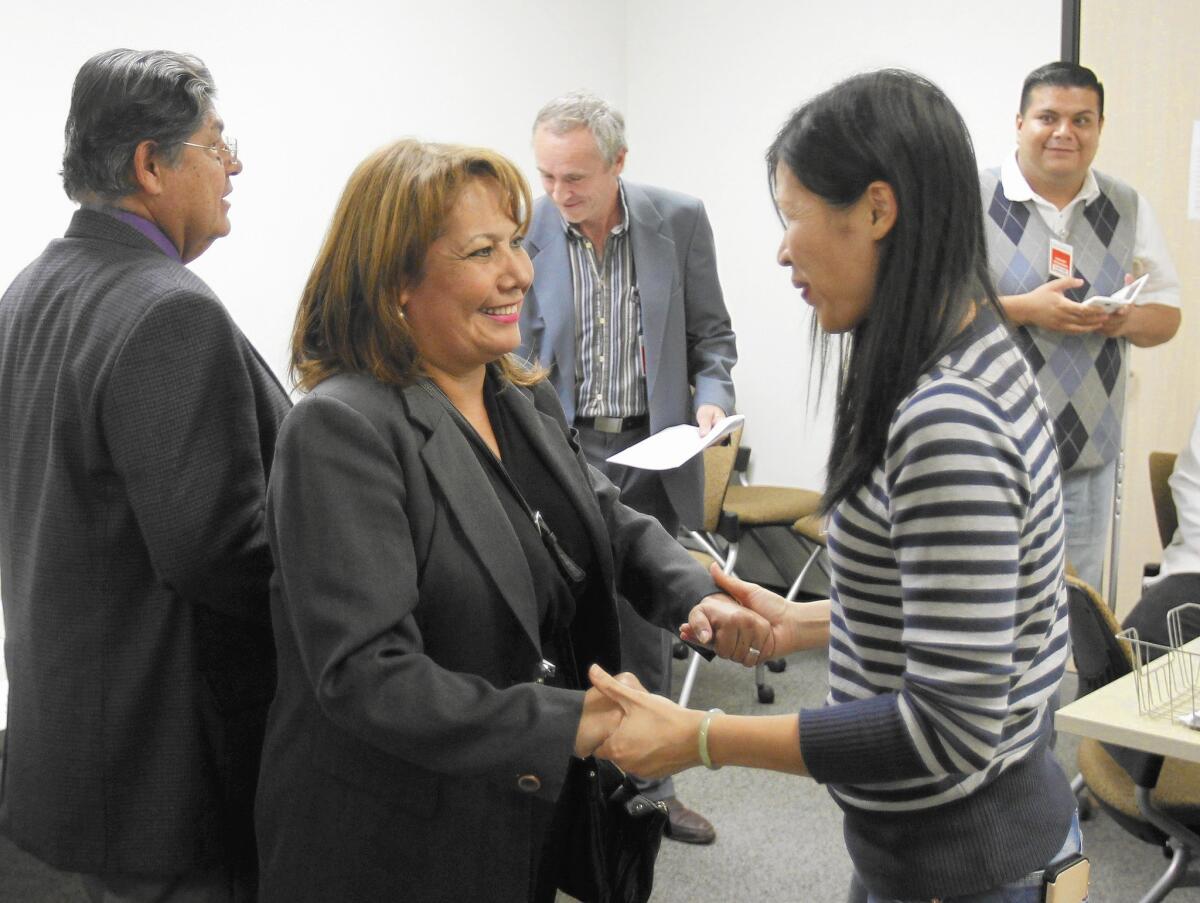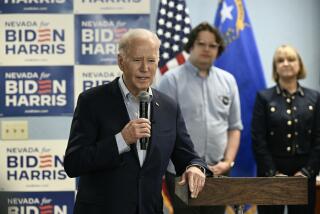California Democrat withdraws support for the high-speed rail project

Assemblywoman Patty Lopez (D-San Fernando), left, says she sees no benefit to her district from California’s high-speed rail project and is withdrawing her support.
The rock-solid Democratic support in Sacramento for the bullet train, which has endured despite legal and financial setbacks in recent years, has developed a political fissure.
Assemblywoman Patty Lopez (D-San Fernando) says she is withdrawing her support for the project, and she says five other Democrats in the Legislature are reviewing their positions.
Lopez said in an interview that the project would damage her mostly Latino, working-class district, which includes Pacoima, San Fernando and Sylmar. The rail route would cut through the district.
SIGN UP for the free Essential Politics newsletter >>
“I don’t see any benefit,” said Lopez, who said it would drive up crime and eliminate businesses in her district. “People are really upset.”
Lopez said the matter should go back to voters, who approved $9 billion in funding for the project in 2008. Lopez said the state has higher priorities, including water, jobs and homelessness, that outweigh the high-speed rail system.
“The money we are going to spend on it is crazy,” she said. Public opinion polls have found that support for the project has eroded as costs have risen.
The Times reported in October that the California High Speed Rail Authority’s contractors warned that the cost of building the Los Angeles-to-San Francisco rail link would exceed the stated budget of $68 billion.
Rail authority executives say they believe the final costs will be below $68 billion, noting that the first two contracts for a portion of the link in the Central Valley have come in under budget.
The first-term assemblywoman did not identify the other Democrats whose support she said was wavering.
If those Democrats do break ranks, the defections still might not cause problems for the project. Gov. Jerry Brown has made the rail link one of his priorities, and he has a deep reserve of support in the Assembly.
In 2012, the first appropriation for the bullet train passed the state Senate by a single vote after three Democrats who were backers of the high-speed rail project withdrew their support. Only the intense lobbying by Brown allowed the measure to pass by a single vote.
Since then, the three senators have been elected to new posts outside the Legislature, leaving Democrats united behind the rail system.
Last year, however, Lt. Gov. Gavin Newsom said he opposed the project, and he argued that other Democrats secretly were against it, despite the overwhelming support of organized labor. Newsom, who is running to succeed Brown as governor in 2018, cited the growing costs and lack of adequate funding to complete the system.
By the time of the 2018 election, construction on the first phase of the rail project, a 220-mph link between Los Angeles and Merced, is supposed to be well underway.
For Lopez, the primary issue is the effect on her low-income community, which has been hurt historically by the construction of three freeways, garbage dumps and other decisions by political power brokers in the state.
This summer, hundreds of protesters from her district showed up at a rail authority board meeting in downtown Los Angeles. And only weeks earlier, protesters brought in their own sound system and took control of a rail authority open house in San Fernando that was supposed to highlight the project’s benefits.
Lopez showed up at a meeting of community groups known as Save Angeles Forest for Everyone, which drew about 100 residents. She wore a vest bearing patches that depicted the four proposed routes in her district, all of them with red slashes through them.
Unless the rail authority can find a politically acceptable route through the Tehachapi and San Gabriel mountains, the line might never get south of the Central Valley.
The routes have produced growing opposition, not only in the smaller working-class areas but between Palmdale and Burbank. Critics say the line could harm wildlife sanctuaries, aquifers, horse ranches, schools, homes, businesses, movie lots and much else. Residents along the route say it is already causing a drop in property value.
The route would pass through one of the largest equestrian communities in Southern California. An estimated 25,000 horses are kept in the area, which includes parts of Lopez’s district, according to Dale Gibson, a rodeo cowboy who serves on the Los Angeles Equine Advisory Board.
A nearby equestrian park would be heavily affected by an above-ground segment of the route, according to David DePinto, president of the Shadow Hills Homeowners Assn. and a leader of the Save Angeles Forest for Everyone organization.
DePinto said the rail authority has reneged on a promise made last June to conduct a study within six months of water, seismic and other environmental effects of the four routes.
The authority says a seismic study will be done by UC San Diego, an equestrian and water study by the Mineta Transportation Institute at Cal State San Jose and a ground water study by Cal State Fullerton. The goal is to identify problems early in the route selection process.
DePinto said the studies are now behind the six-month schedule, and he argued that the selection of Mineta creates a conflict of interest because the rail authority’s chief executive, Jeff Morales, is on the Mineta board and the institute’s past president served on the rail authority board.
“It is completely bogus,” DePinto said.
Linda Philbrick, executive director of the Mineta institute, said it is not receiving any funding from the rail authority for the study.
“Each final draft paper is put through an extensive peer review process whereby two academics and one practitioner provide comments,” Philbrick said. “This is a rigorous, objective method that is fully independent and guided by university principles.”
Lisa Marie Alley, a rail authority spokeswoman, denied that any conflict exists.
The rail authority ran into criticism over the last month as it sought a permit to begin test boring in the mountains to better understand geologically complex rock formations in the ranges. The routes under consideration from Bakersfield to Burbank would require about 36 miles of tunnels.
The U.S. Forest Service opened the permit process to public comment and received scores of letters, most of them fiercely opposing the boring of holes in the forest, part of which includes the San Gabriel National Monument. A permit decision is expected next year.
ALSO
San Bernardino medic had 5 seconds to check if each massacre victim was alive or dead
On skid row, a chorus of hallelujahs for ‘Messiah’
Police seek witnesses in fatal stabbing of homeless man featured in Times story
More to Read
Start your day right
Sign up for Essential California for news, features and recommendations from the L.A. Times and beyond in your inbox six days a week.
You may occasionally receive promotional content from the Los Angeles Times.






